|

Reference Guide
|
|
Using the Printer Software with Windows
Making Changes to Printer Settings
 Making the print quality settings
Making the print quality settings
 Resizing printouts
Resizing printouts
 Modifying the print layout
Modifying the print layout
 Using a watermark
Using a watermark
 Using an overlay
Using an overlay
 Using HDD form overlay
Using HDD form overlay
 Printing with the duplex unit
Printing with the duplex unit
 Making Extended Settings
Making Extended Settings
 Making Optional Settings
Making Optional Settings
Making the print quality settings
You can change the print quality of printouts through settings in the printer driver. With the printer driver, you can make the print settings by choosing from a list of predefined settings, or customizing the settings.
Choosing the print quality by using the Automatic setting
You can change the print quality of printouts to favor speed or detail. There are two levels of print output, 300 dpi and 600 dpi. 600 dpi provides high quality, precise printing, but requires more memory and slows the printing speed.
When Automatic is selected in the Basic Settings menu, the printer driver takes care of all detailed settings according to the color setting you select. Color and resolution are the only settings you have to make. You can change other settings such as paper size or orientation in most applications.
 |
Note:
|
 | |
The printer driver's online help provides details on printer driver settings.
|
|
 |
Click the Basic Settings tab.
|
 |
Click Automatic, then choose desired printing resolution from Fast (300 dpi) or Fine (600 dpi) with the slider bar.
|

 |
Click OK to apply the settings.
|
 |  |
Note:
|
 |  | |
If printing is unsuccessful or a memory-related error message appears, selecting a lower resolution may allow printing to proceed.
|
|
Using the predefined settings
The predefined settings are provided to help you optimize print settings for a particular kind of printout, such as presentation documents or images taken by a video or digital camera.
Follow the steps below to use the predefined settings.
 |
Click the Basic Settings tab.
|
 |
Select Advanced. You will find the predefined settings in the list on the right of Automatic.
|
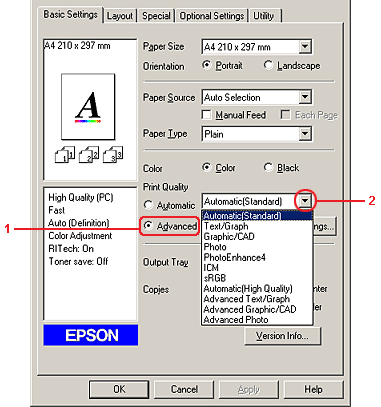
 |  |
Note:
|
 |  | |
This screen may vary depending on your operating system version.
|
|
 |
Select the most appropriate setting from the list according to the type of document or image you want to print.
|
When you choose a predefined setting, other settings such as Printing Mode, Resolution, Screen, and Color Management are set automatically. Changes are shown in the current settings list on the left of the Basic Settings menu.
This printer driver provides the following predefined settings:
Automatic (Standard)
Suitable for regular printing, especially photos.
Text/Graph
Suitable for printing documents that include text and graphs, such as presentation documents.
Graphic/CAD
Suitable for printing graphics and charts.
Photo
Suitable for printing photos.
PhotoEnhance4
Suitable for printing video captures, images taken with a digital camera, or scanned images. EPSON PhotoEnhance4 automatically adjusts the contrast, saturation, and brightness of the original image data to produce sharper, more vivid color printouts. This setting does not affect your original image data.
ICM (Except for Windows NT 4.0)
ICM stands for Image Color Matching. This feature automatically adjusts printout colors to match colors on your screen.
sRGB
When using equipment which supports sRGB, the printer performs Image Color Matching with these pieces of equipment before printing. To confirm that your equipment supports sRGB, contact your equipment dealer.
Automatic (High Quality)
Suitable for printing high-quality printing documents.
Advanced Text/Graph
Suitable for printing high-quality presentation documents that include text and graphs.
Advanced Graphic/CAD
Suitable for printing high-quality graphs, charts, and photos.
Advanced Photo
Suitable for printing high-quality scanned photos and digitally-captured images.
Customizing print settings
If you need to change detailed settings, make the settings manually.
Follow the steps below to customize your print settings.
 |
Click the Basic Settings tab.
|
 |
Click Advanced, then click More Settings.
|
 |
Choose Color or Black as the Color setting, then choose desired printing resolution from 300 dpi or 600 dpi with the Resolution slider bar.
|
 |  |
Note:
|
 |  | |
When making the other settings, see online help for details on each setting.
|
|
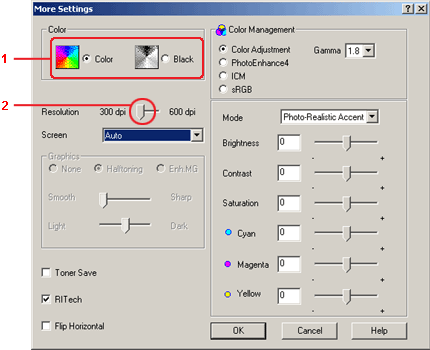
 |  |
Note:
|
 |  | |
This screen may vary depending on your operating system version.
|
|
 |
Click OK to apply the settings and return to the Basic Settings menu.
|
Saving your settings
To save your custom settings, click Advanced, then click Save Settings on the Basic Settings menu. The Custom Settings dialog box appears.
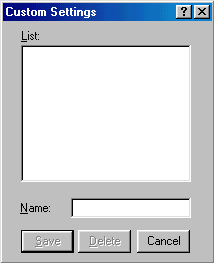
Type a name for your custom settings in the Name box, then click Save. Your settings will appear in the list to the right of Automatic in the Basic Settings menu.
 |
Note:
|
 | -
You cannot use a predefined setting name for your custom settings.
|
|
 | -
To delete a custom setting, click Advanced, click Save Settings in the Basic Settings menu, select the setting in the Custom Settings dialog box, then click Delete.
|
|
 | -
You cannot delete predefined settings.
|
|
If you change any setting in the More Settings dialog box when one of your custom settings is selected in the Advanced Settings list on the Basic Settings menu, the setting selected in the list changes to Custom Settings. The custom setting that was previously selected is not affected by this change. To return to your custom setting, simply reselect it from the current settings list.

[Top]
Resizing printouts
You can have your document enlarged or reduced during printing.
To automatically resize pages to fit the output paper
 |
Click the Layout tab.
|
 |
Select the Zoom Options check box, then select the desired paper size from the Output Paper drop-down list. The page will be printed to fit on the paper you have selected.
|
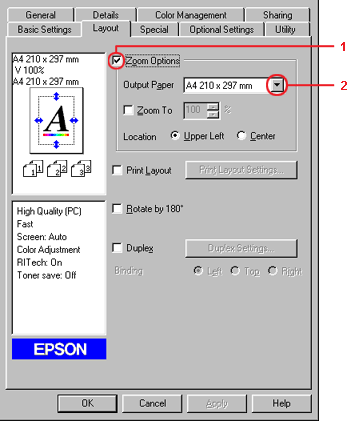
 |
Select Upper Left (to print reduced page image at upper left corner of the paper) or Center (to print reduced page image with centering) for Location setting.
|
 |
Click OK to apply the settings.
|
Resizing pages by a specified percentage
 |
Click the Layout tab.
|
 |
Select the Zoom Options check box.
|
 |
Select the Zoom To check box, then specify the magnification percentage in the box.
|
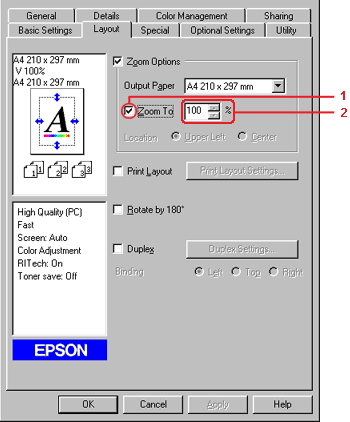
 |  |
Note:
|
 |  | |
The percentage can be set between 50% and 200% in 1% increments.
|
|
 |
Click OK to apply the settings.
|
If necessary, select the paper size to be printed from the Output Paper drop-down list.

[Top]
Modifying the print layout
Your printer can print either two or four pages onto a single page and specifies the printing order, automatically resizing each page to fit the specified paper size. You can also choose to print documents surrounded by a frame.
 |
Click the Layout tab.
|
 |
Select the Print Layout check box, then click Print Layout Settings. The Print Layout Settings dialog box appears.
|
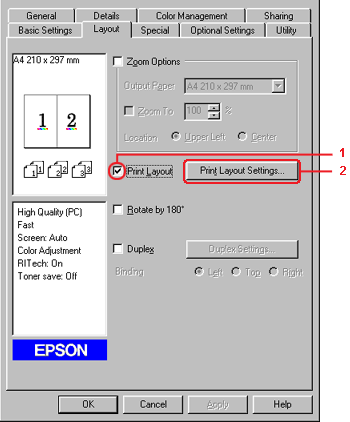
 |
Select the number of pages you want to print on one sheet of paper. Then Select the Page Order in which the pages are printed on each sheet.
|
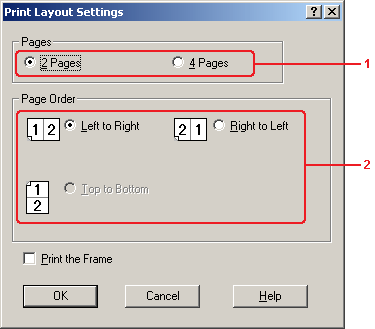
 |
Select the Print the Frame check box when you want to print the pages surrounded by a frame.
|
 |  |
Note:
|
 |  | |
The Page Order choices depend on the number of pages selected above, and the paper orientation (Portrait or Landscape) selected on the Basic Settings menu.
|
|
 |
Click OK to apply the settings and return to the Layout menu.
|

[Top]
Using a watermark
Follow the steps to use a watermark on your document. In the Watermark dialog box, you can select from a list of predefined watermarks, or you can make an original watermark with text or a bitmap. The Watermark dialog box also allows you to make a variety of detailed watermark settings. For example, you can select the size, intensity, and position of your watermark.
 |
Click the Special tab.
|
 |
Select the Watermark check box, then click Watermark Settings. The Watermark dialog box appears.
|
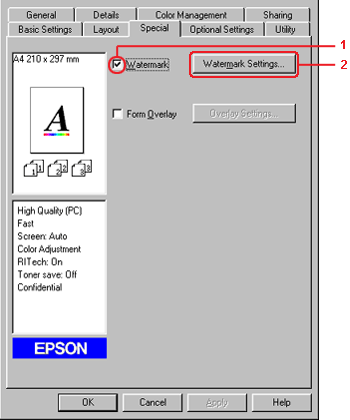
 |
Select a watermark from the Watermark Name drop-down list, then select the color from the Color drop-down list.
|
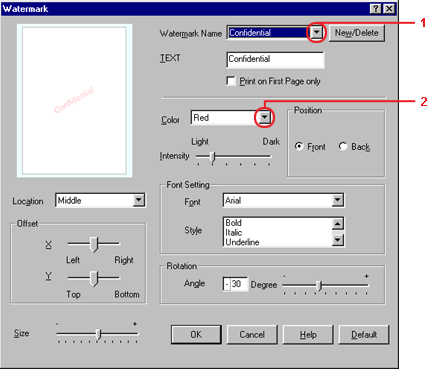
 |
Adjust the image intensity of the watermark with the Intensity slider bar.
|
 |
Select Front (to print the watermark in the foreground of the document) or Back (to print the watermark in the background of the document) for the Position setting.
|
 |
Select the location on the page where you want to print the watermark from the Location drop-down list.
|
 |
Adjust the X (horizontal) or Y (vertical) Offset position.
|
 |
Adjust the size of the watermark with the Size slider bar.
|
 |
Click OK to apply the settings and return to the Special menu.
|
Making a new watermark
You can make a new watermark as follows.
 |
Click the Special tab.
|
 |
Select the Watermark check box.
|
 |
Click Watermark Settings. The Watermark dialog box appears.
|
 |
Click New/Delete. The User Defined Watermarks dialog box appears.
|
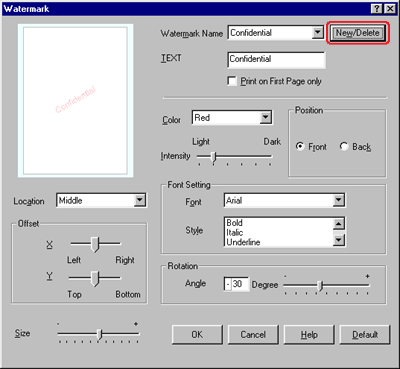
 |
Select Text or BMP and type a name for the new watermark in the Name box.
|
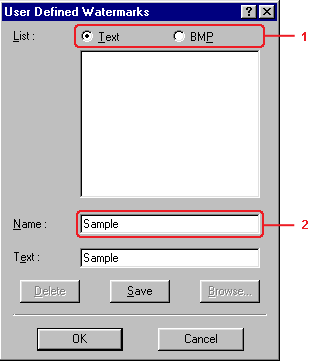
 |  |
Note:
|
 |  | |
This screen appears when you select Text.
|
|
 |
If you select Text, type the watermark text in the Text box. If you select BMP, click Browse, select the BMP file you want to use, then click Open.
|
 |
Click Save. Your watermark will appear in the List box.
|
 |
Click OK to apply the new watermark settings.
|
 |
Note:
|
 | |
You can register up to 10 watermarks.
|
|

[Top]
Using an overlay
The Overlay Settings dialog box allows you to prepare standard forms, or templates, that you can use as overlays when printing other documents. This feature can be useful for creating corporate letterheads or invoices.
 |
Note:
|
 | |
The overlay function is available only when High Quality (Printer) is selected for the Printing Mode in the Extended Settings dialog box from the Optional Settings menu.
|
|
Creating an overlay
Follow the steps below to create and save a form overlay file.
 |
Open your application and create the file that you want to use as an overlay.
|
 |
When the file is ready to be saved as an overlay, choose Print or Print Setup from the File menu of your application, then click Printer, Setup, Options, Properties, or a combination of these buttons, depending on your application.
|
 |
Click the Special tab.
|
 |
Select the Form Overlay check box, then click Overlay Settings. The Overlay Settings dialog box appears.
|
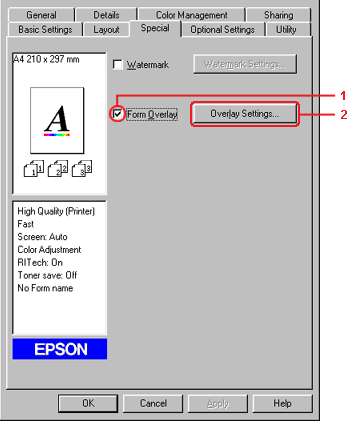
 |
Select Create Overlay Data, then click Settings. The Form Settings dialog box appears.
|
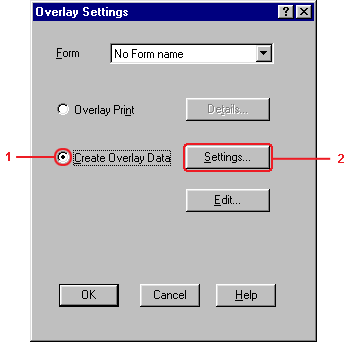
 |
Select the Use Form Name check box, then click Add Form Name. The Add Form dialog box appears.
|
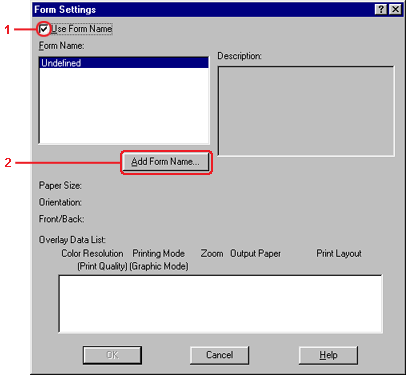
 |
Type the form name in the Form Name box and its description in the Description box.
|
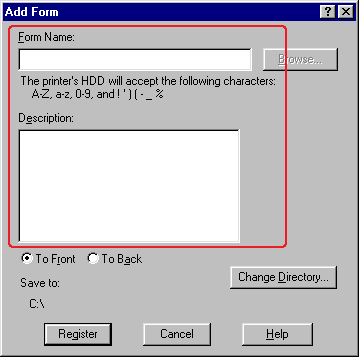
 |
Select To Front or To Back to specify whether the overlay will be printed as background or foreground of the document.
|
 |
Click Register to apply the settings and return to Form settings dialog box.
|
 |
Click OK in the Form Settings dialog box.
|
 |
Click OK in the Overlay Settings dialog box.
|
 |
Print the file saved as overlay data. It is possible to save any kind of file as an overlay. The overlay data is created.
|
Printing with an overlay
Follow the steps below to print a document with overlay data.
 |
Open the file to print with overlay data.
|
 |
From the application, access the printer driver. Open the File menu, choose Print or Print Setup, then click Printer, Setup, Options, Properties, or a combination of these buttons, depending on your application.
|
 |
Click the Special tab.
|
 |
Select the Form Overlay check box, and click Overlay Settings to open the Overlay Settings dialog box.
|
 |
Choose the form from the Form drop-down list, then click OK to return the Special menu.
|
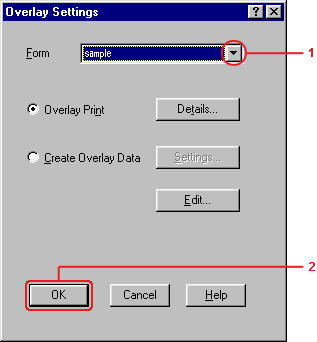
 |
Click OK to print the data.
|
Different printer settings overlay data
The overlay data is made with the current printer settings (such as Resolution: 600 dpi). If you want to make the same overlay with different printer settings (such as 300 dpi), follow the instructions below.
 |
Make the printer settings and exit the printer driver.
|
 |
Send the same data that you made by application to the printer like step 12 in Creating an overlay.
|
This setting is available only for Form Name data.

[Top]
Using HDD form overlay
This function enables faster printing with form overlay data. Windows users can use the form data registered on the optional Hard Disk Drive installed in the printer though only an administrator can register or delete the form data on the Hard Disk Drive. You can access this function from the Form Selection dialog box in the printer driver.
 |
Note:
|
 | -
This function is not available when the Color setting is set to Black in the printer driver's Basic Settings menu.
|
|
 | -
This function is not available if the optional Hard Disk Drive is not installed.
|
|
 | -
Use this function by inputting the registered form name after printing the Print List.
|
|
 | -
When the document's resolution, paper size or paper orientation settings are different from the form overlay data that you use, you cannot print the document with the form overlay data.
|
|
 | -
This function is available in the ESC/Page mode.
|
|
Register the form overlay data on the Hard Disk Drive
Only a network administrator using Windows XP, 2000, NT 4.0, or Server 2003 is allowed to register the form overlay data on the optional Hard Disk Drive. See the Network Guide for details.
Printing with HDD form overlay
All Windows users can use the registered form data on the optional Hard Disk Drive. Follow the steps below to print with HDD form data.
 |
Click the Special tab.
|
 |
Select the Form Overlay check box, and click Overlay Settings. The Overlay Settings dialog box appears.
|
 |
Select No Form name in the Form drop-down list, and click Details. The Form Selection dialog box appears.
|
 |  |
Note:
|
 |  | |
Make sure that No Form name is selected. If any form name is selected, another dialog box will appear.
|
|
 |
Click Printer's HDD, then enter the registered form name.
|
 |  |
Note:
|
 |  |
If you need the list of the registered form data, click Print List to print it and confirm the form name.
Also, if you need a sample print-out of the form data, enter the form name, then click Print Sample.
|
|
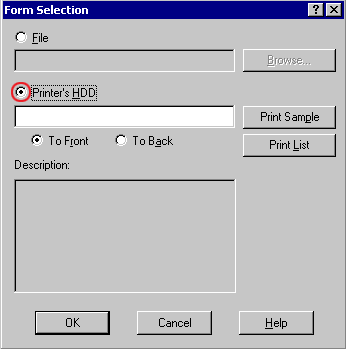
 |
Select To Front or To Back to print the form data as background or foreground of the document, then click OK to return to the Special menu.
|
 |
Click OK to print data.
|
Delete the form overlay data on the Hard Disk Drive
Only a network administrator using Windows XP, 2000, NT 4.0, or Server 2003 is allowed to delete or edit the form overlay data on the optional Hard Disk Drive. See the Network Guide for details.

[Top]
Printing with the duplex unit
Duplex printing prints on both sides of the paper. When printing for binding, the binding edge can be specified as required to produce the desired page order.
As an ENERGY STAR® partner, Epson recommends the use of the double-sided printing function. Refer to ENERGY STAR® Compliance for more information on the ENERGY STAR® program.
 |
Click the Layout tab.
|
 |
Select the Duplex check box, then select Left, Top, or Right as Binding position.
|
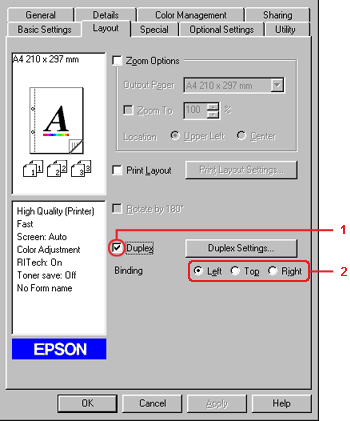
 |
Click Duplex Settings to open the Duplex Settings dialog box.
|
 |
Specify the Binding Margin for the front and back sides of the paper, then select whether the front or back side of the paper is to be printed as the Start Page.
|
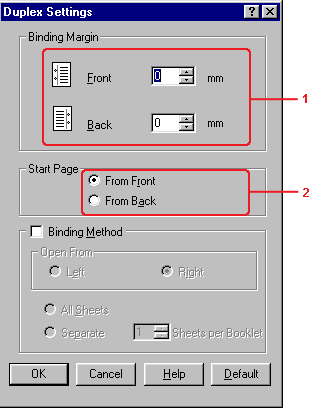
 |
When printing for binding as a booklet, select the Binding Method check box and make appropriate settings. For details about each setting, see online help.
|
 |
Click OK to apply the settings and return to the Layout menu.
|

[Top]
Making Extended Settings
You can make various settings in the Extended Settings dialog box. To open the dialog box, click Extended Settings on the Optional Settings menu.
|
Printing Mode:
|
|
High Quality (PC):
Select this mode if you use a computer with higher specs to reduce the PC load.
In this mode, functions such as "Form Overlay" and "Print true type with fonts with substitution" cannot be used.
High Quality (Printer):
Select this mode if you use a computer with lower specs to reduce the PC load.
CRT:
Select this mode if your printing results are not as good as you wish with "High Quality (PC)" or "High Quality (Printer)." In this mode, functions such as "PhotoEnhance4," "Print Layout," "Binding Method," "Watermark," "Form Overlay" and "Print true type fonts with substitution" cannot be used.
|
|
Print True Type fonts as bitmap button:
|
|
Select this button to print, as bitmap, the True Type fonts that are not substituted with device fonts in the document.
|
|
Print True Type fonts with substitution button:
|
|
Select this button to print the True Type fonts in the document as device fonts. This function is not available when the Printing Mode setting is set to High Quality (PC).
|
|
Settings button:
|
|
Click this button to open the Font Substitution dialog box. This button is available when Print True Type fonts with substitution is selected.
|
|
Uses the settings specified on the printer button:
|
|
Select this button to use the settings specified on the control panel.
|
|
Uses the settings specified on the driver button:
|
|
Select this button to use the settings specified in the printer driver.
|
|
Offset:
|
|
Makes fine adjustments to the printing position on the front and the back of data on a page in 0.5 mm increments.
|
|
Skip Blank Page check box:
|
|
When you select this check box, the printer skips blank pages.
|
|
Ignore the selected paper size check box:
|
|
When you select this check box, the printer prints on loaded paper, regardless of size.
|
|
Automatically change to monochrome mode check box:
|
|
Select this check box to have the printer driver analyze the printing data, and automatically switch to monochrome mode if the printing data is black and white.
|
|
High Speed Graphics Output check box:
|
|
Select this check box to optimize the printing speed of graphics composed of line drawings such as overlaid circles and squares.
Clear this check box if graphics do not print correctly.
|
|
Uses the collate settings specified in the application check box:
|
|
Select this check box to enable the collate settings that are specified on the application.
|
|
Uses the spooling method provided by the operating system check box:
|
|
Select this check box to enable the Spool function for Windows XP, 2000, Server 2003, or NT 4.0.
|
|
Default button:
|
|
Click this button to return the driver settings to the initial settings.
|
|
Help button:
|
|
Click this button to open online help.
|
|
Cancel button:
|
|
Click this button to exit the dialog box or printer driver without saving the settings.
|
|
OK button:
|
|
Click this button to save the settings and to exit the dialog box or printer driver.
|

[Top]
Making Optional Settings
You can update the installed option information manually if you have installed options to your printer.
 |
Click the Optional Settings tab, then select Update the Printer Option Info Manually.
|
 |
Click Settings. The Optional Settings dialog box appears.
|
 |
Make settings for each installed option, then click OK.
|

[Top]
| Version NPD0750-00, Copyright © 2004, SEIKO EPSON CORPORATION |
Making the print quality settings
Resizing printouts
Modifying the print layout
Using a watermark
Using an overlay
Using HDD form overlay
Printing with the duplex unit
Making Extended Settings
Making Optional Settings